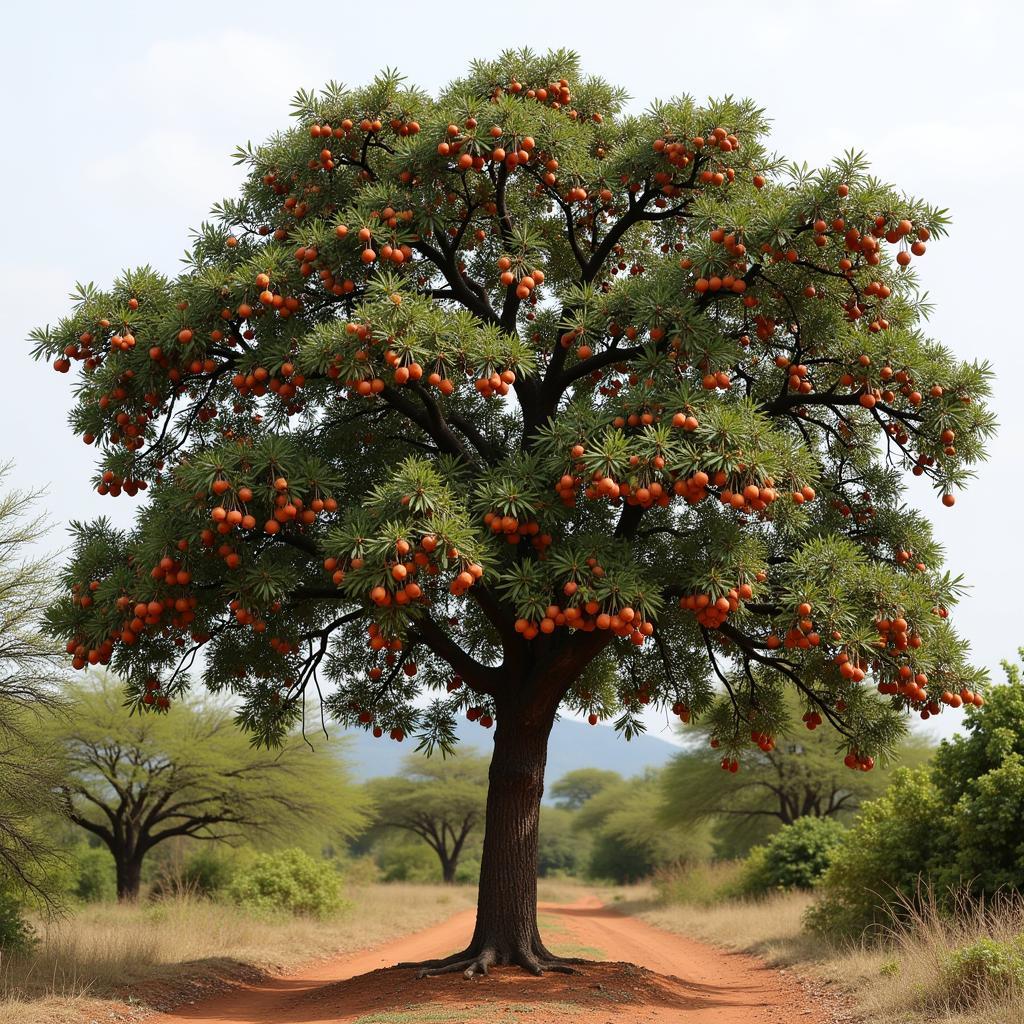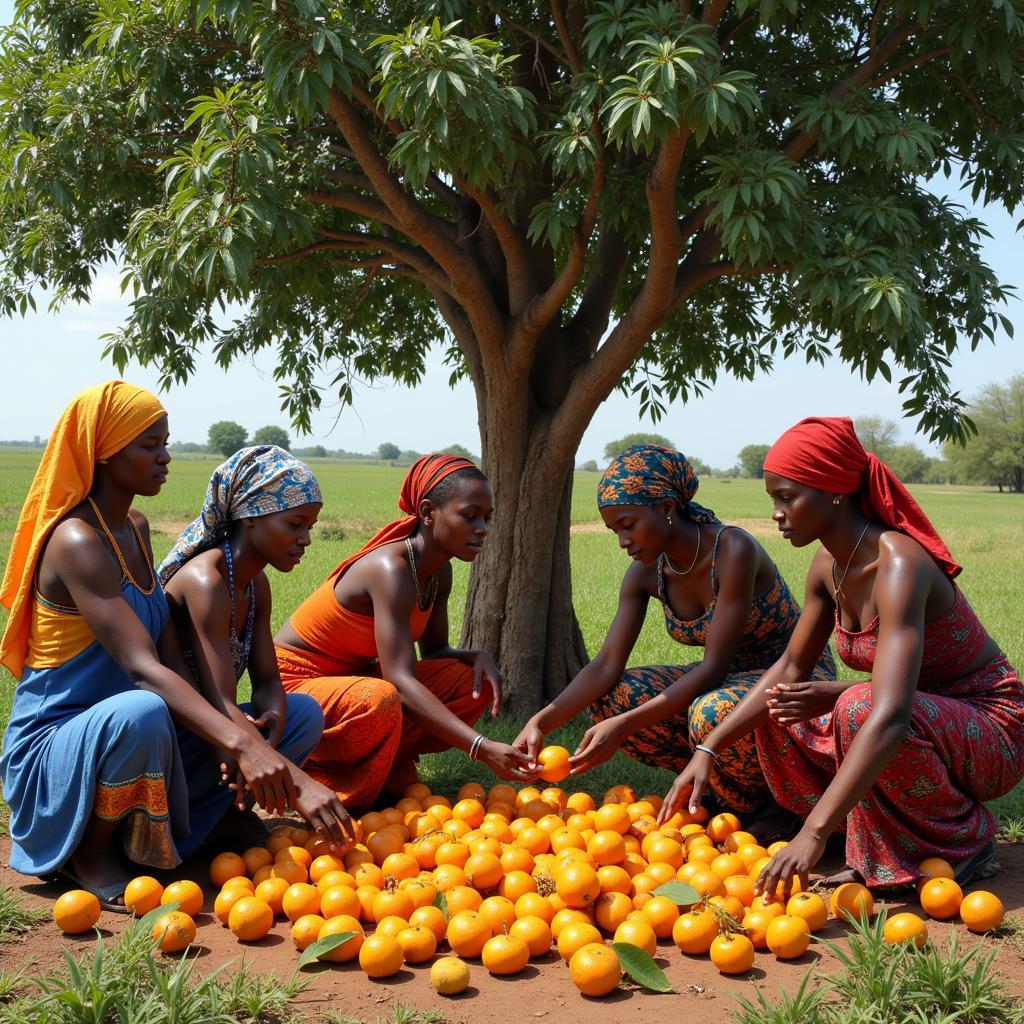Unveiling the African Fruit Medlar: A Taste of History and Tradition
The African Fruit Medlar, known scientifically as Vangueria infausta, is a fascinating fruit with a rich history and deep cultural significance in various parts of Africa. Far from being just another fruit, the medlar embodies a story of resilience, adaptation, and traditional knowledge. Join us as we delve into the captivating world of this unique fruit, exploring its culinary uses, medicinal properties, and its enduring presence in African folklore.
A Fruit of Many Names and Forms
 African fruit medlar tree laden with ripe fruits
African fruit medlar tree laden with ripe fruits
The African fruit medlar is known by a variety of names across the continent, reflecting its widespread distribution and the diverse linguistic landscape of Africa. In South Africa, it is commonly called the “mispel” or “wild medlar,” while in Zimbabwe, it is known as “hute” or “tsubvu.” These varied names are a testament to the fruit’s long-standing presence and its integration into the local cultures.
While the most common variety bears round, reddish-brown fruits, the medlar exhibits variations in size, shape, and color depending on the specific region and growing conditions. This adaptability is a key factor contributing to its resilience and prevalence across different ecological zones.
Culinary Delights: From Tangy Treats to Savory Staples
The African fruit medlar offers a unique flavor profile that has been tantalizing taste buds for generations. When ripe, the fruit has a pleasant, tangy sweetness, reminiscent of tamarind or apricot, with a slightly acidic undertone. This unique flavor lends itself well to both sweet and savory preparations.
In many African cultures, the ripe medlar fruit is enjoyed fresh, often as a refreshing snack. Its tangy juice is also extracted and enjoyed as a beverage, sometimes mixed with water and sugar to create a thirst-quenching drink. The fruit can be processed into jams, jellies, and preserves, providing a taste of summer throughout the year.
 Homemade African fruit medlar jam served with a traditional porridge
Homemade African fruit medlar jam served with a traditional porridge
Beyond sweet treats, the African fruit medlar plays a crucial role in savory dishes as well. In some cultures, the unripe fruit is cooked with meat, adding a tartness that balances the richness of the meat and adds depth to stews and sauces. This culinary versatility speaks volumes about the ingenuity and resourcefulness of African cuisine.
Healing Traditions: Tapping into Nature’s Medicine Cabinet
For centuries, the African fruit medlar has held a revered place in traditional medicine systems across the continent. Various parts of the tree, including its fruits, leaves, and bark, are believed to possess medicinal properties and are used to address a wide range of ailments.
The fruit is a rich source of Vitamin C, a powerful antioxidant known to boost the immune system and protect against infections. Traditional healers often recommend consuming the fruit to combat colds, flu, and scurvy. The leaves are believed to possess anti-inflammatory properties and are used to treat wounds, burns, and skin irritations.
“The African fruit medlar is more than just a fruit; it’s a symbol of our connection to nature and its healing power,” shares Dr. Abena Osei, an ethnobotanist specializing in African medicinal plants. “For generations, our ancestors have relied on this plant for its medicinal benefits, and this knowledge continues to be passed down through generations.”
A Cultural Icon: Woven into the Fabric of African Identity
The African fruit medlar holds a significant place in the cultural tapestry of many African societies. Its presence is woven into folklore, songs, and proverbs, reflecting its deep-rooted significance in everyday life. In some cultures, the tree is considered sacred, symbolizing resilience, abundance, and the interconnectedness of life.
 African women gathering African fruit medlar fruits
African women gathering African fruit medlar fruits
The fruit is often featured in traditional ceremonies and rituals, symbolizing fertility, prosperity, and good fortune. Stories and legends often revolve around the medlar tree, teaching valuable lessons about respect for nature, the importance of community, and the continuity of life.
Conclusion: A Legacy of Flavor, Wellness, and Tradition
The African fruit medlar, with its unique taste, versatile culinary uses, and remarkable medicinal properties, stands as a testament to the richness and diversity of African biodiversity. More than just a fruit, it embodies a legacy of traditional knowledge, cultural heritage, and a deep connection to the natural world. Exploring the world of the African fruit medlar opens a window into the vibrant tapestry of African Life, offering a glimpse into the continent’s rich history, culinary ingenuity, and profound respect for nature’s bounty.



